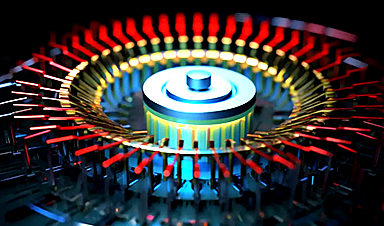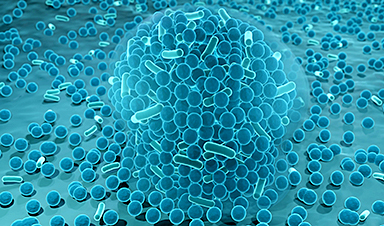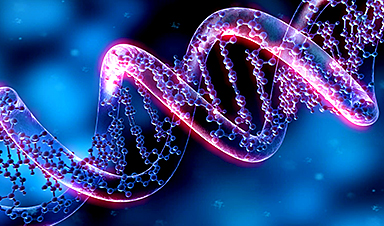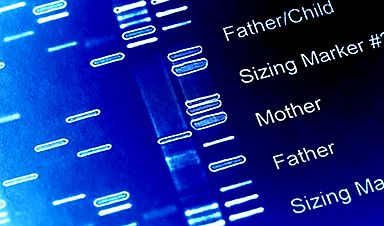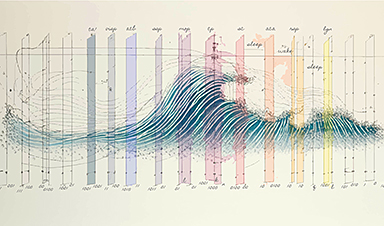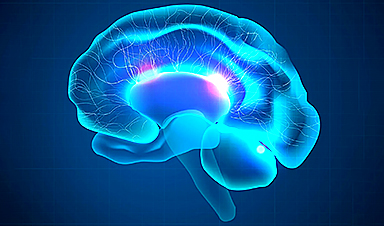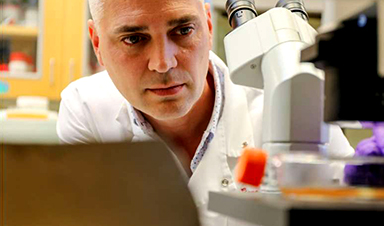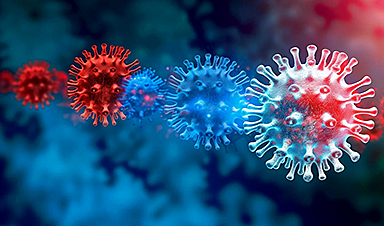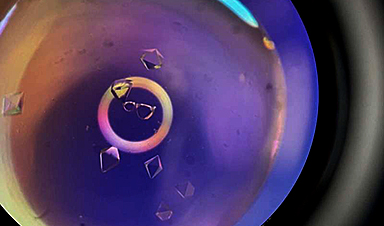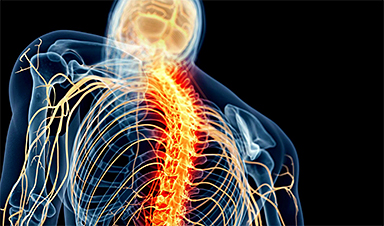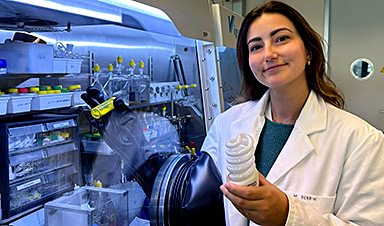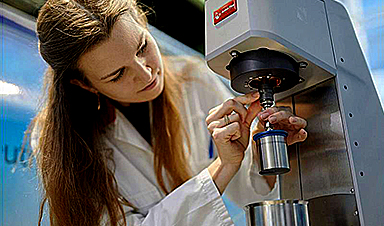Researchers in Germany and Japan have been able to increase the diffusion of magnetic whirls, so-called skyrmions, by a factor of ten.
In today’s world, our lives are unimaginable without computers. Up until now, these devices process information using primarily electrons as charge carriers, with the components themselves heating up significantly in the process. Active cooling is thus necessary, which comes with high energy costs. Spintronics aims to solve this problem: Instead of utilizing the electron flow for information processing, it relies on their spin or their intrinsic angular momentum. This approach is expected to have a positive impact on the size, speed, and sustainability of computers or specific components.
Magnetic Whirls Store and Process Information
Science often does not simply consider the spin of an individual electron, but rather magnetic whirls composed of numerous spins. These whirls called skyrmions emerge in magnetic metallic thin layers and can be considered as two-dimensional quasi-particles. On the one hand, the whirls can be deliberately moved by applying a small electric current to the thin layers; on the other hand, they move randomly and extremely efficiently due to diffusion. The feasibility of creating a functional computer based on skyrmions was demonstrated by a team of researchers from Johannes Gutenberg University Mainz (JGU), led by Professor Dr. Mathias Kläui, using an initial prototype. This prototype consisted of thin, stacked metallic layers, some only a few atomic layers thick.

Two skyrmions antiferromagnetically coupled: The spin in the center and the outside spins are antiparallel to each other. Credit: ill./©: Takaaki Dohi / Tohoku University
Boosting Energy Efficiency
In collaboration with the University of Konstanz and Tohoku University in Japan, researchers of Mainz University have now achieved another step towards spin-based, unconventional computing: They were able to increase the diffusion of skyrmions by a factor of about ten using synthetic antiferromagnets, which drastically reduces the energy consumption and increases the speed of such a potential computer. “The reduction of energy usage in electronic devices is one of the biggest challenges in fundamental research,” emphasized Professor Dr. Ulrich Nowak, who led the theoretical part of the project in Konstanz.
The Power of Antiferromagnets
But what is an antiferromagnet and what is it used for? Normal ferromagnets consist of many small spins, all coupled together to point in the same direction, thereby creating a large magnetic moment. In antiferromagnets, the spins are aligned alternatingly antiparallel, i.e., a spin and its direct neighbors point in the opposite direction. As a result, there is no net magnetic moment, even though the spins remain antiferromagnetically well-ordered. Antiferromagnets have significant advantages, such as three magnitudes of faster dynamics for switching, better stability, and the potential for higher storage densities. These properties are intensively studied in multiple research projects.
In order to understand why these antiferromagnets are useful in this context, we need to delve a bit deeper. When skyrmions move very rapidly, an additional force component arises in ferromagnetic layers perpendicular to the direction of motion. This force component pushes the skyrmions off course. Consequently, they end up colliding with the wall, getting stuck, and obstructing the path for others. At higher speeds, they can even be destroyed. However, it is theoretically known that this effect either does not occur in antiferromagnets or it occurs to a very limited extent.
Advancements in Synthetic Antiferromagnets
To create such an antiferromagnet artificially, the researchers coupled two of their ferromagnetic layers in a way that the magnetization in the two layers is precisely aligned in opposite directions, canceling out their magnetic fields. This provides two advantages: They reduce the force pushing the whirls off their path and thus increase the diffusion. “With this, we have created a synthetic antiferromagnet in which the diffusion of skyrmions is approximately ten times higher than in the individual layers,” said Klaus Raab, a physicist at JGU. “This diffusion can be implemented to realize stochastic computing – a form of computing where stochastic processes like the random motion of particles are utilized.”
The team of researchers investigated the effects of the compensation of the magnetic layers in addition to the influence of temperature and size of the skyrmions on diffusion and consequently on the motion of the skyrmions, both experimentally and through simulations. Intricate connections have been found: As temperature rises, the skyrmions have more energy to diffuse faster. The heat also reduces the size of the skyrmions, which positively affects their mobility. The compensation of the vertical force component also has a positive impact on diffusion. All these effects are difficult to disentangle from each other. “The increasing diffusion seems to be attributable not only to the pure compensation of the magnetic fields but also to the associated reduction in the size of the skyrmions,” summarized Raab.
Professor Mathias Kläui, who led the study, is pleased with the fruitful collaboration with Tohoku University: “We have been working with this leading Japanese university for about ten years and there are even joint study programs. With the support of the German Academic Exchange Service – the DAAD – and other research funders, over a dozen students from Mainz University have already participated in exchanges with Tohoku University. I am delighted that this collaborative effort has been made possible through this cooperation.”
The research results have been published recently in the journal Nature Communications.
Reference: “Enhanced thermally-activated skyrmion diffusion with tunable effective gyrotropic force” by Takaaki Dohi, Markus Weißenhofer, Nico Kerber, Fabian Kammerbauer, Yuqing Ge, Klaus Raab, Jakub Zázvorka, Maria-Andromachi Syskaki, Aga Shahee, Moritz Ruhwedel, Tobias Böttcher, Philipp Pirro, Gerhard Jakob, Ulrich Nowak and Mathias Kläui, 11 September 2023, Nature Communications.
DOI: 10.1038/s41467-023-40720-0
News
Breakthrough in Antimicrobial Technology with Cinnamon-Based Nanokiller
The need for innovative antimicrobial agents has become increasingly urgent due to the rise of antibiotic-resistant pathogens and the persistent threat of infections acquired during hospital stays. Traditional antibiotics and antiseptics are often ineffective [...]
The Silent Battle Within: How Your Organs Choose Between Mom and Dad’s Genes
Research reveals that selective expression of maternal or paternal X chromosomes varies by organ, driven by cellular competition. A new study published today (July 26) in Nature Genetics by the Lymphoid Development Group at the MRC [...]
Study identifies genes increasing risk of severe COVID-19
Whether or not a person becomes seriously ill with COVID-19 depends, among other things, on genetic factors. With this in mind, researchers from the University Hospital Bonn (UKB) and the University of Bonn, in [...]
Small regions of the brain can take micro-naps while the rest of the brain is awake and vice versa
Sleep and wake: They're totally distinct states of being that define the boundaries of our daily lives. For years, scientists have measured the difference between these instinctual brain processes by observing brain waves, with [...]
Redefining Consciousness: Small Regions of the Brain Can Take Micro-Naps While the Rest of the Brain Is Awake
The study broadly reveals how fast brain waves, previously overlooked, establish fundamental patterns of sleep and wakefulness. Scientists have developed a new method to analyze sleep and wake states by detecting ultra-fast neuronal activity [...]
AI Reveals Health Secrets Through Facial Temperature Mapping
Researchers have found that different facial temperatures correlate with chronic illnesses like diabetes and high blood pressure, and these can be detected using AI with thermal cameras. They highlight the potential of this technology [...]
Breakthrough in aging research: Blocking IL-11 extends lifespan and improves health in mice
In a recent study published in the journal Nature, a team of researchers used murine models and various pharmacological and genetic approaches to examine whether pro-inflammatory signaling involving interleukin (IL)-11, which activates signaling molecules such [...]
Promise for a universal influenza vaccine: Scientists validate theory using 1918 flu virus
New research led by Oregon Health & Science University reveals a promising approach to developing a universal influenza vaccine—a so-called "one and done" vaccine that confers lifetime immunity against an evolving virus. The study, [...]
New Projects Aim To Pioneer the Future of Neuroscience
One study will investigate the alterations in brain activity at the cellular level caused by psilocybin, the psychoactive substance found in “magic mushrooms.” How do neurons respond to the effects of magic mushrooms? What [...]
Decoding the Decline: Scientific Insights Into Long COVID’s Retreat
Research indicates a significant reduction in long COVID risk, largely due to vaccination and the virus’s evolution. The study analyzes data from over 441,000 veterans, showing lower rates of long COVID among vaccinated individuals compared [...]
Silicon Transformed: A Breakthrough in Laser Nanofabrication
A new method enables precise nanofabrication inside silicon using spatial light modulation and laser pulses, creating advanced nanostructures for potential use in electronics and photonics. Silicon, the cornerstone of modern electronics, photovoltaics, and photonics, [...]
Caught in the actinium: New research could help design better cancer treatments
The element actinium was first discovered at the turn of the 20th century, but even now, nearly 125 years later, researchers still don't have a good grasp on the metal's chemistry. That's because actinium [...]
Innovative Light-Controlled Drugs Could Revolutionize Neuropathic Pain Treatment
A team of researchers from the Institute for Bioengineering of Catalonia (IBEC) has developed light-activated derivatives of the anti-epileptic drug carbamazepine to treat neuropathic pain. Light can be harnessed to target drugs to specific [...]
Green Gold: Turning E-Waste Into a Treasure Trove of Rare Earth Metals
Scientists are developing a process inspired by nature that efficiently recovers europium from old fluorescent lamps. The approach could lead to the long-awaited recycling of rare earth metals. A small molecule that naturally serves [...]
Cambridge Study: AI Chatbots Have an “Empathy Gap,” and It Could Be Dangerous
A new study suggests a framework for “Child Safe AI” in response to recent incidents showing that many children perceive chatbots as quasi-human and reliable. A study has indicated that AI chatbots often exhibit [...]
Nanoparticle-based delivery system could offer treatment for diabetics with rare insulin allergy
Up to 3% of people with diabetes have an allergic reaction to insulin. A team at Forschungszentrum Jülich has now studied a method that could be used to deliver the active substance into the [...]
